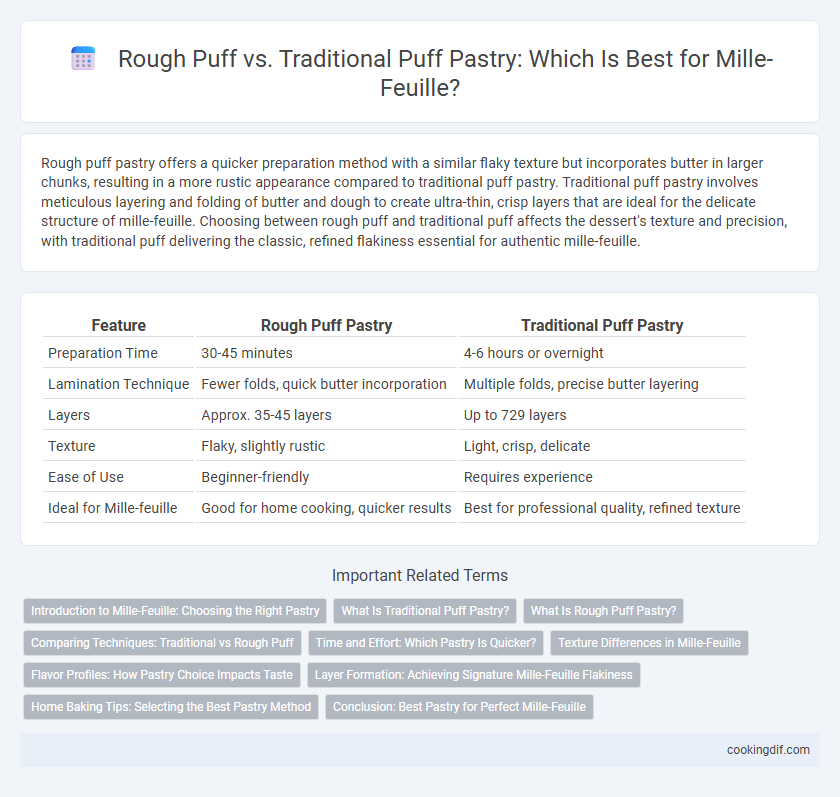Rough puff pastry offers a quicker preparation method with a similar flaky texture but incorporates butter in larger chunks, resulting in a more rustic appearance compared to traditional puff pastry. Traditional puff pastry involves meticulous layering and folding of butter and dough to create ultra-thin, crisp layers that are ideal for the delicate structure of mille-feuille. Choosing between rough puff and traditional puff affects the dessert's texture and precision, with traditional puff delivering the classic, refined flakiness essential for authentic mille-feuille.
Table of Comparison
| Feature | Rough Puff Pastry | Traditional Puff Pastry |
|---|---|---|
| Preparation Time | 30-45 minutes | 4-6 hours or overnight |
| Lamination Technique | Fewer folds, quick butter incorporation | Multiple folds, precise butter layering |
| Layers | Approx. 35-45 layers | Up to 729 layers |
| Texture | Flaky, slightly rustic | Light, crisp, delicate |
| Ease of Use | Beginner-friendly | Requires experience |
| Ideal for Mille-feuille | Good for home cooking, quicker results | Best for professional quality, refined texture |
Introduction to Mille-Feuille: Choosing the Right Pastry
Mille-feuille, a classic French dessert, relies on delicate layers of pastry to achieve its signature texture. Rough puff pastry offers a quicker preparation with flakier, more rustic layers, while traditional puff pastry delivers precise, ultra-light, and consistent lamination ideal for the mille-feuille's refined structure. Selecting the right pastry balances convenience with the desired flakiness and crispness essential for an authentic mille-feuille experience.
What Is Traditional Puff Pastry?
Traditional puff pastry, also known as pate feuilletee, is a laminated dough made by folding layers of butter and dough repeatedly to create countless thin, flaky layers. This process produces a light, crisp texture essential for mille-feuille, allowing the pastry to rise evenly and achieve its signature delicate flakiness. The slow, precise lamination distinguishes traditional puff pastry from rough puff, delivering superior lift and a finer crumb structure ideal for classic French desserts.
What Is Rough Puff Pastry?
Rough puff pastry is a quicker, less time-consuming alternative to traditional puff pastry, combining butter and dough in larger, uneven layers to create a flaky texture. Unlike traditional puff, which requires meticulous folding and resting periods to develop dozens of thin layers, rough puff achieves a similar rise and crispness with fewer folds and a simpler process. This makes rough puff ideal for mille-feuille when time constraints exist but a delicate, layered pastry is still desired.
Comparing Techniques: Traditional vs Rough Puff
Traditional puff pastry for mille-feuille involves an extensive lamination process with multiple folds and turns, creating delicate, even layers that puff uniformly during baking. Rough puff pastry incorporates a quicker technique by mixing butter in chunks and fewer folds, resulting in a less uniform but still flaky texture. While traditional puff offers superior crispness and refinement ideal for classic mille-feuille, rough puff provides a practical alternative with reduced preparation time and sufficient flakiness.
Time and Effort: Which Pastry Is Quicker?
Rough puff pastry requires significantly less time and effort compared to traditional puff pastry when preparing mille-feuille, as it involves fewer turns and quicker lamination steps. Traditional puff pastry demands multiple rest periods and precise folding to achieve its signature flaky texture, extending the preparation process. For bakers seeking efficiency without sacrificing texture, rough puff offers a faster alternative while still providing a layered, buttery result suitable for mille-feuille.
Texture Differences in Mille-Feuille
Rough puff pastry features a flakier, more rustic texture with uneven, irregular layers that create a crispy bite in mille-feuille, while traditional puff pastry offers a uniformly delicate, airy, and finely layered structure resulting in a light, tender mouthfeel. The rough puff's texture holds fillings with slightly more resistance, enhancing the contrast between crunchy pastry and creamy custard. Traditional puff pastry's smooth, consistent layers are ideal for achieving the classic, melt-in-the-mouth sensation associated with authentic mille-feuille.
Flavor Profiles: How Pastry Choice Impacts Taste
Rough puff pastry offers a slightly denser texture with a buttery, rustic flavor that complements the creamy layers of mille-feuille, enhancing its richness. Traditional puff pastry provides a lighter, flakier crust with a delicate, crisp profile that contrasts beautifully with the smooth pastry cream. The choice between rough puff and traditional puff directly influences the balance of richness and crispness, shaping the overall taste experience of the mille-feuille.
Layer Formation: Achieving Signature Mille-Feuille Flakiness
Rough puff pastry creates distinct, flaky layers through a quicker lamination process using larger butter pieces, resulting in a slightly denser texture ideal for a rustic mille-feuille. Traditional puff pastry, with its meticulous, repeated folding and thinner butter layers, produces ultra-fine, delicate layers that deliver the signature lightness and crispness essential to classic mille-feuille flakiness. Layer formation in traditional puff ensures maximum rise and separation, achieving the iconic airy texture that defines authentic mille-feuille desserts.
Home Baking Tips: Selecting the Best Pastry Method
Rough puff pastry offers a quicker, more manageable option for home bakers making mille-feuille, with its flaky layers achieved through folding butter into dough without extensive resting times. Traditional puff pastry requires precise lamination and longer chilling periods, producing a more delicate, ultra-flaky texture ideal for professional-quality mille-feuille. Choosing rough puff pastry balances ease and texture, making it suitable for beginners seeking satisfying results without the complexity of classic puff pastry techniques.
Conclusion: Best Pastry for Perfect Mille-Feuille
Rough puff pastry offers a quicker, easier method with satisfactory flakiness and buttery layers, making it suitable for home bakers aiming for convenience without compromising texture. Traditional puff pastry, crafted through numerous folds and rest periods, provides the most delicate, crisp layers essential for an authentic, gourmet mille-feuille experience. For achieving the perfect mille-feuille with optimal rise, flakiness, and structural integrity, traditional puff pastry remains the preferred choice among professional pastry chefs.
Rough puff vs traditional puff for mille-feuille Infographic

 cookingdif.com
cookingdif.com